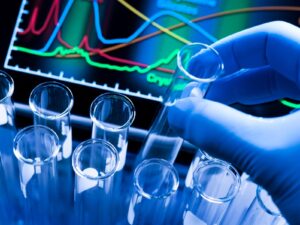TECHNOLOGIST IN CHEMISTRY
- Description
- Curriculum
- Reviews
-
1ENZYMES OF CLINICAL SIGNIFICANCE
Enzymes catalyze physiologic reactions by lowering the activation energy level that the reactants (substrates) must reach for the reaction to occur.
Clinically significant enzymes are: (Oxidoreductases, Transferases, Hydrolases, Lyases, Isomerases, Ligases.
-
2AMINO ACIDS AND PROTEINS
-
3NON-PROTEIN NITROGENOUS COMPOUNDS
The biochemistry, clinical utility, and analytical methods for measurement of the NPN compounds urea, uric acid, creatinine, creatine, and ammonia are presented in this chapter.
-
4BLOOD GASES, pH , BUFFER SYSTEMS AND ACID-BASE DISORDERS
An acid is a substance that can donate hydrogen ions (H+) when dissolved in water. A base is a substance that can accept hydrogen ions. pH of a solution is defined as the negative log of the hydrogen ion conc.
-
5ELECTROLYTES AND OSMOLALITY
Electrolytes are ions (minerals) capable of carrying an electric charge. Electrolytes with a positive charge are cations that move toward the cathode, while those with a negative charge are anions that move toward the anode.
-
6HYPOTHALAMIC AND PITUITARY FUNCTION
-
7ADRENAL FUNCTION
-
8GONADAL FUNCTION
-
9THYROID HORMONOLOGY
-
10CALCIUM HOMEOSTASIS AND HORMONAL REGULATION
Serum calcium level is maintained at a constant level for the optimal excitability of neural and muscular tissue and the coordinated functioning of various organ systems.
-
11MARKERS OF CARDIAC DAMAGE
-
12TUMOR MARKERS
-
13THERAPEUTIC DRUG MONITORING
-
14DRUG METABOLISM, ELIMINATION AND HALF-LIFE
-
15TOXICOLOGY









